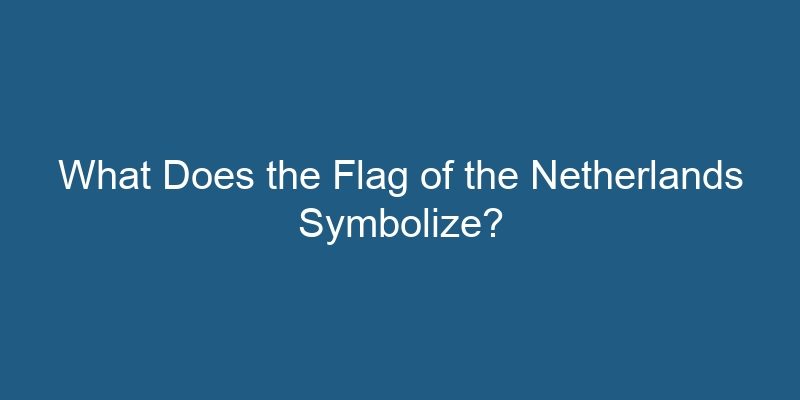The flag of the Netherlands, commonly known as the Dutch flag, is a tricolor consisting of three horizontal bands of equal width. From top to bottom, the colors are red, white, and blue. While the flag may seem simple at first glance, it holds great symbolism and historical significance for the Dutch people. Let us delve into the various aspects and meanings associated with the flag of the Netherlands.
- History of the Dutch Flag
- The Colors of the Dutch Flag
- 1. Red
- 2. White
- 3. Blue
- Symbolism and Meaning
- 1. National Identity
- 2. Independence and Freedom
- 3. International Relations
- Usage and Display of the Dutch Flag
- 1. National Holidays and Celebrations
- 2. Sporting Events
- 3. Mourning and Remembrance
- 4. Government Buildings and Institutions
- Conclusion
History of the Dutch Flag
The origins of the Dutch flag can be traced back to the 16th century when the Netherlands was fighting for independence against the Spanish Empire. During this time, the Dutch rebels used the Prince’s Flag, which consisted of three horizontal orange-white-blue bands, as their symbol. The orange color represented the Dutch royal family, the House of Orange-Nassau. However, as the rebellion progressed, the orange dye used to produce the orange band often faded to red. This led to the eventual adoption of the red-white-blue tricolor as the official flag of the Netherlands in the early 17th century.
The Colors of the Dutch Flag
The three colors of the Dutch flag, red, white, and blue, each hold their own significance and symbolism.
1. Red
The top band of the Dutch flag is red, which represents bravery, strength, and valor. It symbolizes the Dutch people’s courage and determination throughout their history, particularly during times of struggle and conflict.
2. White
The middle band of the flag is white, symbolizing peace, purity, and honesty. The color white represents the Dutch people’s commitment to diplomacy, fairness, and their desire for harmony both domestically and internationally.
3. Blue
The bottom band of the flag is blue, which signifies loyalty, justice, and steadfastness. Blue represents the Dutch people’s dedication to upholding their values and principles, as well as their commitment to the rule of law.
Symbolism and Meaning
The flag of the Netherlands not only represents the Dutch people’s values and aspirations but also carries a deeper symbolism and meaning.
1. National Identity
The Dutch flag is a powerful symbol of national identity for the people of the Netherlands. It represents their history, culture, and shared experiences as a nation. The flag is proudly displayed during national celebrations, sporting events, and other significant occasions, fostering a sense of unity and patriotism among the Dutch population.
2. Independence and Freedom
The Dutch flag is a reminder of the Netherlands’ struggle for independence and its ongoing commitment to freedom. It serves as a symbol of the Dutch people’s determination to govern themselves and protect their individual liberties. The flag is often associated with the Dutch resistance during World War II, further emphasizing its significance in the fight against oppression and tyranny.
3. International Relations
The Dutch flag plays a crucial role in diplomatic relations and international cooperation. It is proudly displayed in embassies, consulates, and during official visits, representing the Netherlands as a sovereign nation and a member of the global community. The flag serves as a visual representation of Dutch values, principles, and commitment to peace, justice, and equality.
Usage and Display of the Dutch Flag
The Dutch flag is prominently displayed in various settings and occasions throughout the Netherlands.
1. National Holidays and Celebrations
During national holidays such as King’s Day, Liberation Day, and National Flag Day, the Dutch flag is seen across the country. It is hoisted on public buildings, private residences, and even on boats sailing through the canals. The flag serves as a symbol of national pride and unity during these festive occasions.
2. Sporting Events
When it comes to sports, the Dutch flag is widely displayed to cheer on Dutch athletes and teams. Whether it’s football, speed skating, or any other sport, fans proudly wave the flag to show their support and solidarity.
3. Mourning and Remembrance
In times of mourning or to commemorate significant events, the Dutch flag may be flown at half-mast as a sign of respect and remembrance. This solemn display honors the lives lost and serves as a collective gesture of grief and solidarity.
4. Government Buildings and Institutions
The Dutch flag is a common sight on government buildings, including the Royal Palace, parliament, and ministries. It symbolizes the authority and sovereignty of the Dutch state, as well as the democratic principles and values upon which it is founded.
Conclusion
The flag of the Netherlands, with its iconic red, white, and blue tricolor, is far more than just a piece of cloth. It represents the Dutch people’s history, values, and aspirations. The red symbolizes bravery, the white signifies peace, and the blue represents loyalty. The flag serves as a symbol of national identity, independence, and freedom, both domestically and internationally. Whether displayed during national celebrations, sporting events, or in official settings, the Dutch flag is a powerful emblem that unites and inspires the Dutch population.










